七年级下册英语课教案
- 格式:docx
- 大小:15.29 KB
- 文档页数:13
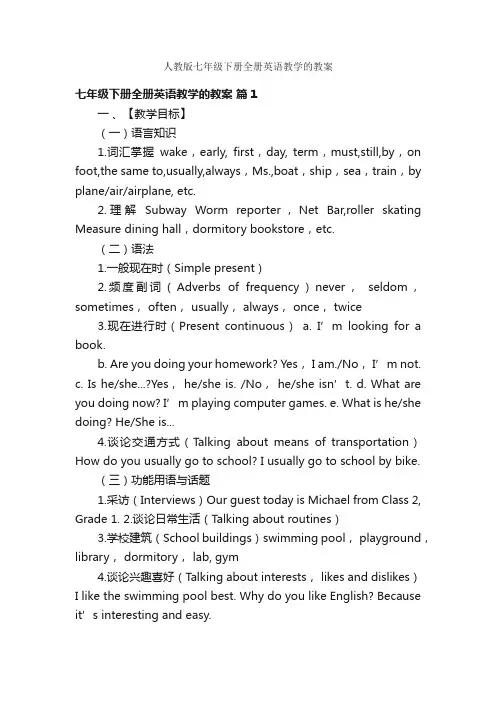
人教版七年级下册全册英语教学的教案七年级下册全册英语教学的教案篇1一、【教学目标】(一)语言知识1.词汇掌握wake,early, first,day, term,must,still,by,on foot,the same to,usually,always,Ms.,boat,ship,sea,train,by plane/air/airplane, etc.2.理解Subway Worm reporter,Net Bar,roller skating Measure dining hall,dormitory bookstore,etc.(二)语法1.一般现在时(Simple present)2.频度副词(Adverbs of frequency)never,seldom,sometimes, often, usually, always, once, twice3.现在进行时(Present continuous)a. I’m loo king for a book.b. Are you doing your homework? Yes, I am./No,I’m not.c. Is he/she...?Yes, he/she is. /No,he/she isn’t.d. What are you doing now? I’m playing computer games.e. What is he/she doing? He/She is...4.谈论交通方式(T alking about means of transportation)How do you usually go to school? I usually go to school by bike.(三)功能用语与话题1.采访(Interviews)Our guest today is Michael from Class 2, Grade 1.2.谈论日常生活(Talking about routines)3.学校建筑(School buildings)swimming pool, playground,library, dormitory, lab, gym4.谈论兴趣喜好(Talking about interests, likes and dislikes)I like the swimming pool best. Why do you like English? Because it’s interesting and easy.5.借物(Borrowing things)How long can I keep it? Two weeks.6.新闻(News)、海报(Poster)Attention,please! Here is the news.7.谈论学校活动、科目和时间表(Talking about school activities,subjects and timetable)8.谈论学校生活(Talking about school life)(四)能力培养【听】能听懂谈论校园生活中比较熟悉的话题,识别主题,获取主要信息。
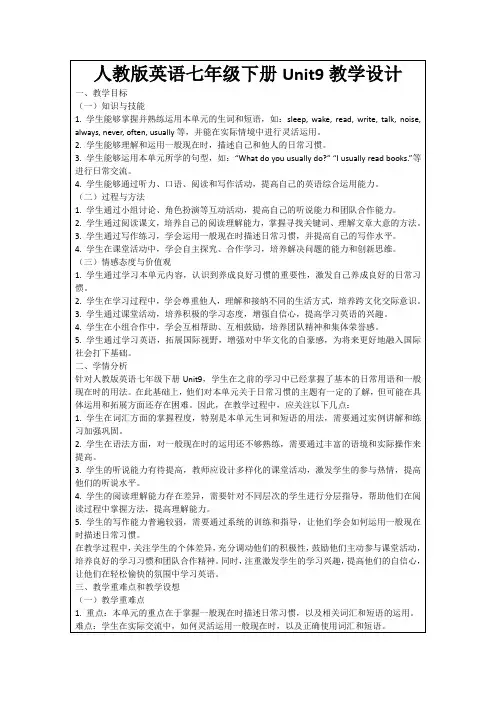
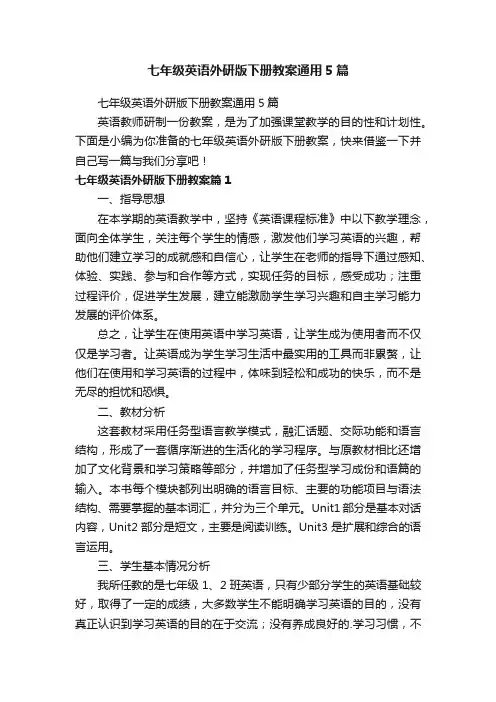
七年级英语外研版下册教案通用5篇七年级英语外研版下册教案通用5篇英语教师研制一份教案,是为了加强课堂教学的目的性和计划性。
下面是小编为你准备的七年级英语外研版下册教案,快来借鉴一下并自己写一篇与我们分享吧!七年级英语外研版下册教案篇1一、指导思想在本学期的英语教学中,坚持《英语课程标准》中以下教学理念,面向全体学生,关注每个学生的情感,激发他们学习英语的兴趣,帮助他们建立学习的成就感和自信心,让学生在老师的指导下通过感知、体验、实践、参与和合作等方式,实现任务的目标,感受成功;注重过程评价,促进学生发展,建立能激励学生学习兴趣和自主学习能力发展的评价体系。
总之,让学生在使用英语中学习英语,让学生成为使用者而不仅仅是学习者。
让英语成为学生学习生活中最实用的工具而非累赘,让他们在使用和学习英语的过程中,体味到轻松和成功的快乐,而不是无尽的担忧和恐惧。
二、教材分析这套教材采用任务型语言教学模式,融汇话题、交际功能和语言结构,形成了一套循序渐进的生活化的学习程序。
与原教材相比还增加了文化背景和学习策略等部分,并增加了任务型学习成份和语篇的输入。
本书每个模块都列出明确的语言目标、主要的功能项目与语法结构、需要掌握的基本词汇,并分为三个单元。
Unit1部分是基本对话内容,Unit2部分是短文,主要是阅读训练。
Unit3是扩展和综合的语言运用。
三、学生基本情况分析我所任教的是七年级1、2班英语,只有少部分学生的英语基础较好,取得了一定的成绩,大多数学生不能明确学习英语的目的,没有真正认识到学习英语的目的在于交流;没有养成良好的.学习习惯,不能做好课前预习课后复习,不善于发现和总结语言规律,不注意知识的巩固和积累。
四、具体措施1、每天背诵课文中的重点对话。
目的:要求学生背诵并默写英语句子,培养学生良好的英语语感。
2、每天听写本节课中需要用到的重点生词,常用句子或习语。
利用“互测及教师抽查”及时检查,保证效果并坚持下去。
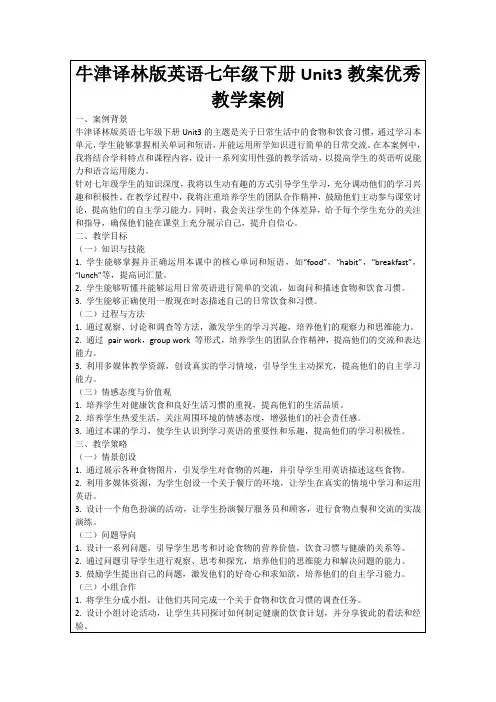
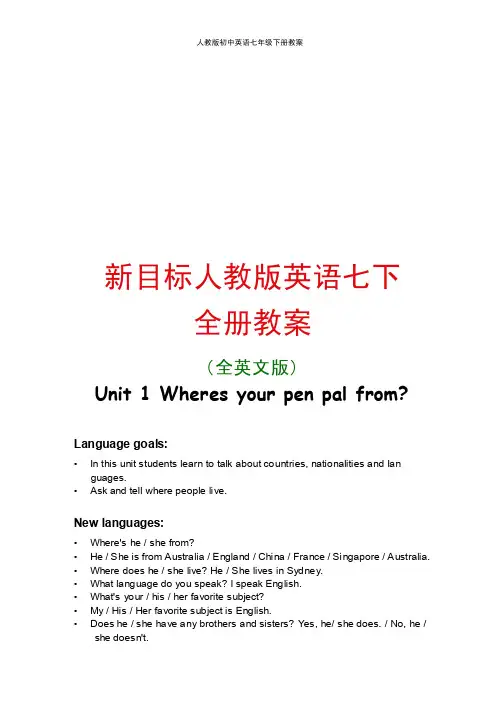
新目标人教版英语七下全册教案(全英文版)Unit 1 Wheres your pen pal from?Language goals:•In this unit students learn to talk about countries, nationalities and Ian guages.•Ask and tell where people live.New languages:•Where's he / she from?•He / She is from Australia / England / China / France / Singapore / Australia. •Where does he / she live? He / She lives in Sydney.•What language do you speak? I speak English.•What's your / his / her favorite subject?•My / His / Her favorite subject is English.•Does he / she have any brothers and sisters? Yes, he/ she does. / No, he / she doesn't.Difficult points:1. Liste ning for the in formation about cou ntries, natio nalities and Ian guages. Write an e-mail about on eself. Describe the new stude nts in class.2. Where questions with fromWhere questions with liveWhat questi onsTeaching aids:• A tape recorderTeaching periods:•Period 1:Section A 中1a, 1b, 1c•Period 2:Section A 中2a, 2b, 2c, 2d•Period 3:Section A 中3a, 3b, 4•Period 4:Section B 中1,2a, 2b, 2c•Period 5:Section B 中3a, 3b, 3c, 4•Period 6:Self CheckPeriod 1Teaching aims:1. Teach vocabulary words.2. Target Ianguages:Where's your pen pal from?He is from Australia.3. Enable the students to learn to talk about nationalities.4. Help the students learn how to talk about nationalities.Teaching procedures:Step 1. Free talk2 Say: Do you have any friends? Where is she from?Help the students make the same sentences and give them more chances to say.Step 2. Talking about the picture (1a)Hold up the picture on page 1 and point at the map. Ask students toread the picture.Ask some of you to read them aloud to the class. Make the studentstalk about where people are from.Say: Du Chuan, where is your pen pal from?Ask the students to read the conversations in the picture.Step 3. Listening (1b)Point to the numbered list of words and play the recording for a secondtime.Ask the students to listen to the recording and circle the countries in 1a.Ask students to listen to and repeat after the recording and then checkthe answers.Step 4. Pair work(1c)1. Now work in pairs and read the conversations in 1a with your partner.You can talk about your own pen pal.2. Ask the students to look at their own clothes and the things in theirbackpack. Ask and answer questions about where they are from.Homework1. Ask the students to practice talking about where people are from and make up real dialogues.2. Learn the words in this unit (on page 115) by heart.Period 2Teaching aims:1. Learn the vocabulary words and useful expressions.2. Target languages: Where does he live? He lives in Toronto.3. Let the students learn to talk about where people live.4. Help the students learn how to talk about where people live.Teaching procedures:Step I.StepI RevisionCheck the homework. And then ask several students to answer questi ons.Say: Where are you from? Do you have a pen pal? Where is your pen pal from?Step 2. Presentation (2a)Put a map of the world on the blackboard.Say: What's the meaning of capital? Can you guess? Help them to answer.Write Australia, the United States, Canada, France, and Japan on theleft of the blackboard. And write Sydney, New York, Paris, Toronto, andTokyo on the right of the blackboard. And the teacher reads them aloudand asks students to repeat.Then ask students to match the cities with the countries.Step 3. Talk about countries and citiesAsk the students to work in pairs, asking about the cities and the countries.Say: Now work in pairs and ask where the city is. For example, the firststudent asks "Where is Beijing?” the second student answers “It's inChina."Then tell the students to ask question about Chinese cities.Step 4. Listening (2b, 2c)Tell the students to read the list of countries and cities in 2a.Say: Now let's look at the list of countries and cities in Activity 2a. I will ask some students to read them aloud to the class.Call the students' attention to the chart in 2c.Tell the students to listen to the conversations in Step 4 again to complete the chart.Step 5. Pair work(2d)Ask the students to read the conversations in the bubble. Then askthem to talk about the in formation in the chart in 2c.Then ask the students to work in groups and make up new dialogueswith their own information.Step 6.GrammarfocusReview the grammar box.Say: You have to pay attention the word "from". It always follows verb be, while live comes out alone in where sentences. Now make more sentences with where, from and live.Write the following on the blackboard.Say, now work in pairs and make dialogues after the model above.Homework1. Ask the stude nts to learn the sentence patter ns in Grammar Focus by heart. Try to use them freely.2. Remember the words in this unit (on page 115).3. Make a similar dialogue according to the conversation in 2d.Period 3Teaching aims:1. Teach vocabulary words.2. Target Ianguages: What Ianguage does she speak? She speaks English.3. Enable the students to learn to talk about what Ianguage people speak.4. Help the students to learn how to talk about what language people speak.Step 1. Free talkSay, Morning, boys and girls. Nice to see you again. Do you remember we have learned about how to ask where people are from and how to ask where people live? Now I want some of you to answer my questi ons.(Turn to a student.)Where are you from?Give more students chances to speak in class.Step 2. Presentation (3a)Say: Do you know the meaning of "Ianguage"? Listen: Tim is from England and he speaks English. So English is his Ianguage. I'm fromChina, so Chinese is my language .Now look at activity 3a.on page 3.Read the instructions to the class. Ask students to work in pairs as theyanswer the questions.Show the flowing and ask the students to make conversations after themodel.Step 3. Pair work (3b)Ask the students to pay attention to the conversation in Activity 3b.Say, Read the dialogue by yourselves. Then I will ask some pairs to act out the dialogue in class.Show a map of the world. Ask students to work in pairs.Step 4. Quiz(4)Ask the students to look at activity 4 then work in pairs and do the quiz.HomeworkAsk the students to work with their friends and practice the dialogue in activity 3b.Period 4Teaching aims1. Teach vocabulary words.2. Target languages:Does she have any brothers and sisters?Is that your new pen pal?Yes, it is.3. Enable the students to learn to talk about their new pen pals.4. Help the students learn how to talk about their new pen pals.Step 1. RevisionAsk the students to make conversations talking about their new pen pal.Ask some pairs to the front to talk about their pen pals. Greet each otherand have a free talk with classmates.Talk about the persons they admire.Step 2.Match work (1)Ask the students to pay attention to the notebook page with the countries listed.Ask the students to write the letter of the correct country in the box next to the title of each Ianguage textbook on the desktop.Step 3. Listening (2a, 2b)First, read the instructions and tell the students to read the conv ersati on bubbles.Check the answers. Then ask the students to read the questions again.Ask the students to fill in the chart.Give students 1 minute to finish the task. Check the answers with the stude nts.Then play the recording again and ask the students to repeat.Step 4. Pair work (2c)Ask two students to work in pairs, practicing the questions in activity 2a.Then tell the students to practice dialogues similar to the dialogue inactivity 2a in pairs. They can use their own names.HomeworkAsk the students to make up similar dialogues using the following words: Sam, the Unites Sates, New York, a brother and a sister, English and French.Period 5Teaching aims1. Teach vocabulary words.2. Target languages:I think China is a very interesting country.I like going to the movies with my friends and playing sports.My favorite subject in school is P.E.It's fun. / It's too difficult.3. Enable the students to write a pen pal letter.4. Help the students learn how to write to a pen pal.Step 1 .Warming upSay, Do you have a pen pal? Whafs his name? Does he have any brothers and sisters? What Ianguage does he speak?Then ask the students to work in pairs to talk about their pen pal.Step 2. Reading (3a)Ask the students to read the letter on page 5.Point the four questions beneath the letter.When the students finish reading the letter, ask the four questions orally and ask them to answer orally.Ask the students to retell the letter, using their own words.Step 3. Reading and writing (3b)Ask the students to pay attention to the letter from Tom King.Point out the blanks in the letter and the information card on the right.Correct the an swers. Then draw the in formation card on the blackboard and then ask the students try to retell the letter.Step 4. WritingAsk the students make their own information card.After they are finished, ask several students to read their e-mails in class.HomeworkAsk the students to choose one of the following tasks as homework.1. Show a name card to the students and ask them to write something about it.2. The students change their information card with their partner and writesomething about their partner.Period 6Teaching aims:1. Teach vocabulary words.2. Enable the students to describe the new students in the class.3. Help the students learn to describe the new students in the class.Teaching procedures:Step 1. RevisionPractice talking about one of the students.Say, Take out your information cards. And change it with your partner.Read it carefully and make up an oral practice, talking about yourpartner.Step 2.Key word checkAsk the students to read all the words in this part.Say: In learning to talk about where people are from, you learned many words on the topic. Now read and check the words you know in 1 on page6. Then say a sentence with each of them.Step 3.Vocab-BuildersAsk students to write five new words in their Vocabulary-Builder on page 112. After they are finished, ask two students to write their words down on the blackboard. And ask them to read the words and the whole class repeat. And tell the whole class to remember them after class.Step 4.WritingLet the students pay attention to the pictures.Say, Look at the picture of Sally. How old do you think she is? Where do you think she is from? What language do you think she speaks? What do you think she likes? What do you think she dislikes?The same step goes with Jim and Julie.After a few minutes, ask some students to read their descriptions to the class.Step 5.SpeakingAsk the students to do an oral practice about the new classmates.Say, There are several new students in our class this term. Who do youlike best? Why do you like him or her? Please tell us. First you can tellyour partner.Ask some students to present their work to the class.Step 6. Just for Fun!Ask all students to read the conversation.Let the students practice in pairs.HomeworkAsk the students to summarize what they have learned in this unit and prepare for the next unit.Unit 2 Where is the post office?Language goals:•In this unit students learn to talk about asking for and give directions on the street.New languages:•Excuse me, is there a bank near here?•Yes, there is. It's on Center Street.•Where is the pay phone?•lt*s across from / next to / in front of / behind the library.•lt*s between the post office and the library.•Just go straight and tum left.•Turn left on First Avenue.•Take a walk through the park on Center Avenue.•There is a clean / dirty park near my house.Difficult points:1. Listening for the information of the names of the neighborhoodRead the tour guide and an e-mail from a friend you're going to visitWrite the dialogues about asking the way and giving directions.2. Where questions.Affirmative statementsPrepositions of placeTeaching aids:• A tape recorder•Some picturesTeaching periods:Period 1: Section A1a, 1b, 1cPeriod 2: Section A2a, 2b, 2cPeriod 3: Section A3a, 3b, 4Period 4: Section B 1a, 1b, 1c, 2a, 2b, 2cPeriod 5: Section B 3a, 3b, 3c, 4Period 6: Self CheckPeriod 1Teaching aims:1. Teach vocabulary words.2. Target Ianguages: Is there a bank near here? Yes, there is. It's on CenterStreet.3. En able the stude nts to ask for and give di recti ons on the street.4. Help the students to ask for and give directions on the street.Teaching procedures:Step 1. Warming upShow three pictures prepared before class to the students. There is acat in a box in picture 1. There is a cat on a box in picture 2. There is acat under the box in picture 3.Then ask some students to ask and answer these questions.Step 2.Match work (2a)Ask the students to read the picture and the words in the numbered list.Ask the students to match each word or phrase on the list with one of the pictures.Then check the answers.Present the new sentence patterns.Then ask the students to read the dialogue in the picture.Step 3. Listening (1b)Ask the students to listen to the conversations and circle the places in 1a.Change the roles and do the same again.Then students ask and answer without the help of the recording.Step 4. PracticePoint to the different locations shown in the picture. Ask different students to name each one.Then point to more locations and let the students to practice more.Homework1. Practice the conversation in the picture on page 7.2. Learn the new words and phrases in this period by heart.Period 2Teaching aims:1. Learn the vocabulary words and useful expressions.2. Target languages:The pay phone is across from the library.The pay phone is next to the library.The pay phone is between the post office and the library.The pay phone is on Greet Street.The pay phone is in front of the library.The pay phone is behind the library.3. Enable the students to talk about the position of a place.4. Help the students to talk about the position of a place.Teaching procedures:Step 1. Revision and warming upCheck the homework by talking about the pictures on page 7 with thestudents or prepare some other pictures with different buildings in itand let the students practice asking and answering questions about theplaces.Ask the students to practice more.Step 2. Presentation (2a)Introduce the items across from, next to, between, in front of, behind and on.Draw the following picture on the blackboard.Park 3 Centre StreetEncourage or help the students to answer: It's across from the library.The same way goes with next to, on and in front of.Ask the students to match each sentence with one of the pictures.Then ask the students to read the six sentences and match thesentences the pictures.Check the answers.Step 3. Listening(2b)Review the buildings and street names in Activity 1a and the six sentences in 2a.The read the six sentences in 2b to the class.Ask the students to listen to the recording and fill in the blanks.Play the tape. Check the answers.Step 4. Practice (2c)Ask the students to repeat the conversations after the recording.Ask the students to do the Pair work asking and answering questions about the places in 1a.Step 5.Grammar FocusAsk the students to read the sentences in the grammar box aloud. The ask them to answer the following questions. Explain some Ianguage points if the students can't understand.Homework• Ask the students to practice talking about their neighborhood in pairs.Period 3Teaching aims:1. Teach vocabulary words.2. Target Ianguages:Just go straight and turn left.It*s down Bridge Street on the right.Ifs next to a supermarket.3. Enable the students to talk about the neighborhood.4. Help the students to talk about the neighborhood.Teaching procedures:Step 1. RevisionLet the students look at the picture in activity 1a. And ask some studentsto answer some questions in order to check the homework.Say, Is there a library near here? Where is it? Is there a bank near here?Where is it?Put up the picture of activity 2a on the blackboard and ask them to makeconversations.Step 2. Presentation (3a)Guide the students to guess the meanings of the three traffic signs. Show the pictures and ask some questions about the pictures.Then ask the students to hold up their left hands and then their right hands to practice “left” and "right".Point to the picture and let the students read the conversation.Ask the students to read the conversations. Then ask them to find Paul and Nancy in the picture.Ask the students to role play the conversation then point out the place that Paul wants to get to.Step 3. Complete the conversations (3b)Ask the students to make conversations and answer the questionsbelow each picture.The students point out the place in the picture. And write down theanswers on the line in the pictures. Or ask a pair of students to say theconversation, the others point to the speakers' place.Step 4. GameAsk the students to look at the picture in Activity 1a and name all thebuildi ngs.Ask some students to read the conversation in the picture in Activity 4.And then explain the instruction to the student.Then ask some groups to present their work.Homework• Ask the students to make a similar conversation to that in Activity 3a.Period 4Teaching aims:1. Teach vocabulary words.2. Target languages:Is there a big supermarket near your house?Yes, there is.There is a big supermarket.No! There is a small supermarket.3. Enable the students to describe the neighborhood.4. Help the students to describe the neighborhood.Teaching procedures:Step 1. RevisionCheck the homework by asking the following questions.Say, Look at the picture in activity 3a. Suppose you are standing nearthe building on the side of New Street. Please answer my questions.Excuse me. Is there a pay phone in the neighborhood?Ask another student to answer questions.Give more students chances to practice this dialogue.Step 2.Match work (1a)Bring in some objects or pictures to the students. (Two rulers, one is old, the other is new. Two boxes, one is big and the other is small. Two bottles, one is clean and the other is dirty. Two pictures of a street, one is busy and the other is quiet.)Say, Look at the rulers, please. Can you find the differenee between them?Yes. This one is old. (Show the old ruler.) And this one is new. (Show the new ruler.) Do you understand old and new?Ask the students to talk about the picture.Point to each half of each picture and ask about the differenee between the halves.Go on with the other pictures to teach the language items. Ask thestudents to match the words with the pictures.Step 3. Pair workCall attention to the conversation in the picture.Then ask the students to work in pairs and take turns asking each other questions about the things on the list of phrases in activity 1a on page 7.Step 4. Listening (2a, 2b)Ask the students to listen to the tape and circle the places in 1a.Say: Now please listen to the tape again. Listen to it and draw the places in Michael's neighborhood on the street map. Just listen.Play the recording.Play the recording again.Then have some students show their completed drawing to the class. Step 5. Pair workAsk the students to work in pairs talking about drawings to the class. Then ask some pairs to present their dialogues to the class.Ask the students to work in pairs, draw a map of their own neighborhood and practice asking and answering questions about the places they live in.Homework• Ask the students to make similar conversations to that in Activity 1 b.Period 5Teaching aims:1. Teach vocabulary words.2. Target languages:Turn left on First Avenue and enjoy the city's quiet streets and small parks.Take a walk through the park on Center Avenue.This is the beginning of the garden tour.Bridge is a good place to have fun.3. Enable the students to write a tour guide and draw the rout to somewhere.4. How to write a tour guide and draw the rout to somewhere.Teaching procedures:Step 1. RevisionCheck the homework by asking about the students neighborhood.Ask the students to work in pairs.Ask the students to work in pairs.Then ask some pairs to present their conversations to the whole class. Step 2. Reading (3a, 3b)Ask the students to read the tour guide.Divide the whole class into four groups to have a quiz.Tell the students to keep these words down and make at least twosentences with each word after class.After that ask the students to look at the pictures and fill in the blanks for this tour guide.Step 3.WritingAsk the students to write a tour guide with the students.Names of buildings and locations.Description wordsWords that talk about positions.Words that talk about di recti ons.Step 4. Pair work (4b)Learn to draw a picture of neighborhood. First ask the students toanswer the questions according to the pictures.Then ask the students to draw a picture according to the following conversati on.Then ask students to present their drawings to the whole class.Homework1. Ask the students to talk about the street and buildings in their own neighborhood.2. Ask the students to make sentences with the description words they keptdown in the class.Period 6Teaching aims1. Teach vocabulary words.2. Target Ianguages:I know you are arrivi ng n ext Sun day.Let me tell you the way to my house.I hope you have a good trip.3. Enable the students to write about the neighborhood.4. Help the students to learn how to write about the neighborhood.Teaching procedures:Step 1. RevisionCheck the homework by asking and answering some questions.Give more students chances to practice.Step 2.Key word check(1)Ask the students to check the words they know.Then ask the students to do the some exercises.Step 3.Vocab-Builders (2)Expand the students' vocabulary.After that ask the students to share their list with other students.Step 4. ReadingAsk the students to read the letter and draw the rout on the map.Ask the students to change the letter into a telephone conversation.Let the students pay attention to the pictures.Say, Look at the picture of Sally. How old do you think she is? Where do you think she is from? What language do you think she speaks? What do you think she likes?What do you think she dislikes?The same step goes with Jim and Julie.After a few minutes, ask some students to read their descriptions to the class.Step 5. Just for Fun!Call attention to the conversation in the cartoons.Ask the students to read the conversation and then answer the questi ons.Homework• Ask the students to do the following:1. Suppose your frie nd is going to visit you. He does n't know the way toyour house. Write a letter to him to tell him the route from the bus stop to your house.2. Review the next unit.Unit 3 Why do you like koalas?Language goals:•In this unit students learn to describe animals and express preferences.New languages:•Let's see the pandas first.•Why do you like want to see the pan das?•Because they are very cute.•Because they*re kind of shy.•Because they're kind of interesting.•Because they are fun.•Because they are smart.•Do you like giraffes?•Where are lions from?•They are from South Africa.•The animal is ugly / beautiful / friendly / small / shy / clever / cute / scary. •She likes to play with her friends and eat grass.•She's very beautiful, but she's very shy, so please be quiet•He sleeps during the day, but at night he gets up and eats leaves.Difficult points:1. Listening for the names of animals. Listen for the description words about animals.2. Read the description words about animals. Write about the animal you know.3. why, what, where questions, because, adjectives of qualityTeaching aids:• A tape recorder•Some picturesTeaching periods:•Period 1: Section A1a, 1b, 1c•Period 2: Section A2a, 2b, 2c•Period 3: Section A3a, 3b, 4•Period 4: Section B 1a, 1b, 1c, 2a, 2b, 2c•Period 5: Section B 3a, 3b, 3c, 4• Period 6: Self CheckPeriod 1Teaching aims:1. Teach vocabulary words.2. Target languages:Let's see the pan das.Why do you want to see the lions?Because they*re cute.3. Enable the students to talk about animals.4. Help the students learn how to listen to and talk about animals.Teaching procedures:Step 1. Warming upTalk about animals using pictures.Teach new words about animals by the pictures.Step 2.Match work (1a)Ask the students to read the words and the picture, and then match thenames with the pictures a-h.Encourage or help the students to say something about the picture anddo the match work.Step 3. Listening (1b)Point to the numbered list of words in activity 1a and play the recording.Ask the students to listen to the recording and circle the countries in 1a.Play the tape and then check the answers.Ask the students to listen to and repeat after the recording and thencheck the answers.Further activity: Ask the students to do some pair work in the followingway if they can understand the listening material well.Step 4. Pair work (1c)Ask the students to make conversations in pairs.Show the following.—Let's see the pan das / giraffes / lions / penguins / dolphi ns / koalas / elepha nts / tigers?—Why?——Because they're cute / interesting / fun / interesting / smart.Say: Now please make conversations in pairs, using the animals in activity 1a and the description words in activity 1c.Homework1. Ask the students to remember the new words in this period (on page 116) by heart.2. Ask the students to practice the conversation in activity 1 c.Period 2Teaching aims:1. Learn the vocabulary words and useful expressions.2. Target languages:I like dolphins.Why do you like dolphins?Because they are kind of interesting.3. Enable the students to talk about animals and tell why they like them.4. Help the students learn to talk about animals and tell why they like them. Teachi ng procedures:Step 1. Free talk and lead-inRevise the names of the animals.Say: In last period we learnt the names of some animals. Now let's do some revision. Please look at the pictures one by one and you have to tell me the name of the animal in the picture. OK?Show the students the animal pictures one by one.Revise the conversation learnt in the last period.Give more chances to more students to practice talking about the animals and expressing why they like the animals.Step 2. Listening (2a, 2b)First ask the students to listen and fill in the chart in activity 2a.Play the recording for the first time. Ask the students to listen carefully and write down the animals.Play the tape the second time.Ask the students to pay attention to the words in the box in Activity 2b.Ask the students to pay attention to the conversation in activity 2b. After that, check the answers.Then ask the students to listen to and repeat the dialogue after therecording.After this, ask the students to practice the conversation without the help of the recording.Step 3. Pair work (2c)Ask the students to work in pairs, ask and answer about animals they know.Ask the students to practice: Why? Because they are...Step 4.GrammarfocusAsk the students to read the sentences in the grammar box and sum up the sentence structure.Practice suggest!on: Ask the students to work in groups and write down。
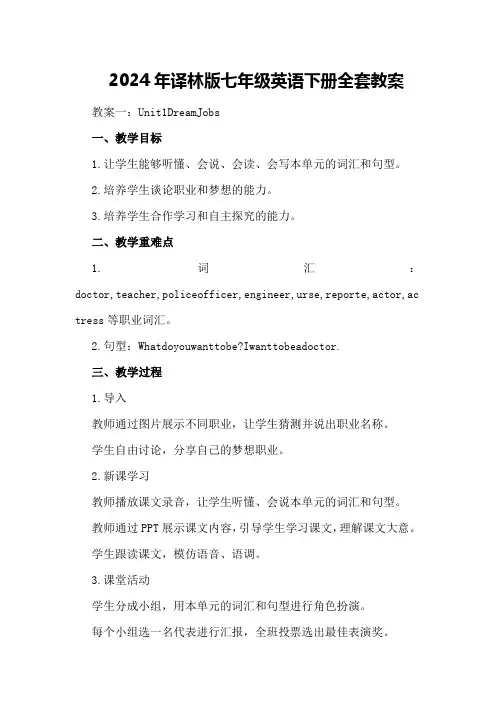
2024年译林版七年级英语下册全套教案教案一:Unit1DreamJobs一、教学目标1.让学生能够听懂、会说、会读、会写本单元的词汇和句型。
2.培养学生谈论职业和梦想的能力。
3.培养学生合作学习和自主探究的能力。
二、教学重难点1.词汇:doctor,teacher,policeofficer,engineer,urse,reporte,actor,ac tress等职业词汇。
2.句型:Whatdoyouwanttobe?Iwanttobeadoctor.三、教学过程1.导入教师通过图片展示不同职业,让学生猜测并说出职业名称。
学生自由讨论,分享自己的梦想职业。
2.新课学习教师播放课文录音,让学生听懂、会说本单元的词汇和句型。
教师通过PPT展示课文内容,引导学生学习课文,理解课文大意。
学生跟读课文,模仿语音、语调。
3.课堂活动学生分成小组,用本单元的词汇和句型进行角色扮演。
每个小组选一名代表进行汇报,全班投票选出最佳表演奖。
4.练习巩固教师设计一些练习题,让学生独立完成,巩固所学知识。
学生相互检查,纠正错误。
5.作业布置让学生用本单元的词汇和句型写一篇关于自己梦想职业的短文。
四、教学反思教案二:Unit2SchoolLife一、教学目标1.让学生能够听懂、会说、会读、会写本单元的词汇和句型。
2.培养学生谈论学校生活和课程安排的能力。
3.培养学生合作学习和自主探究的能力。
二、教学重难点1.词汇:math,English,Chinese,science,art,music,PE等课程名称。
2.句型:Whatsubjectsdoyouhave?Wehavemath,English,Chinese,science,ar t,music,andPE.三、教学过程1.导入教师通过图片展示不同课程,让学生猜测并说出课程名称。
学生自由讨论,分享自己的课程安排。
2.新课学习教师播放课文录音,让学生听懂、会说本单元的词汇和句型。
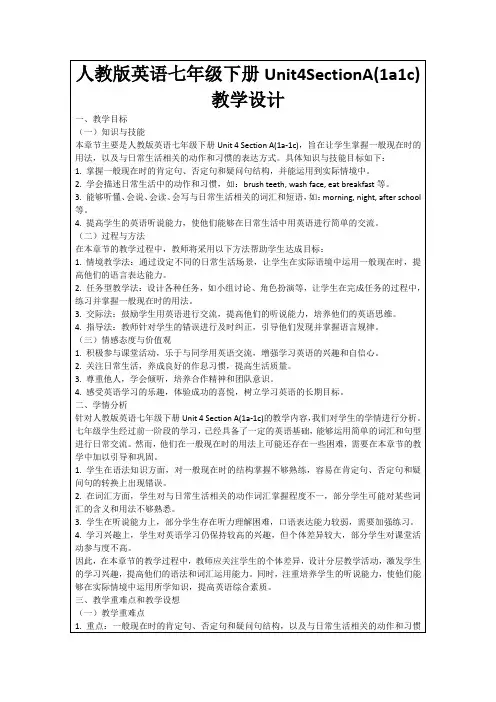
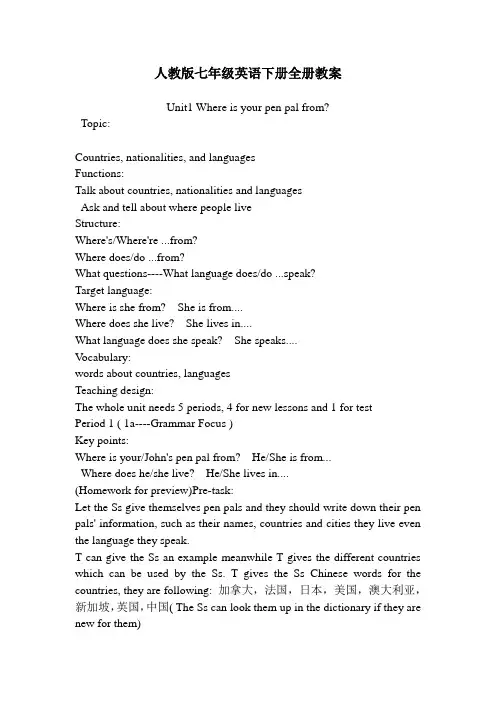
人教版七年级英语下册全册教案Unit1 Where is your pen pal from?Topic:Countries, nationalities, and languagesFunctions:Talk about countries, nationalities and languagesAsk and tell about where people liveStructure:Where's/Where're ...from?Where does/do ...from?What questions----What language does/do ...speak?Target language:Where is she from? She is from....Where does she live? She lives in....What language does she speak? She speaks....V ocabulary:words about countries, languagesTeaching design:The whole unit needs 5 periods, 4 for new lessons and 1 for testPeriod 1 ( 1a----Grammar Focus )Key points:Where is your/John's pen pal from? He/She is from...Where does he/she live? He/She lives in....(Homework for preview)Pre-task:Let the Ss give themselves pen pals and they should write down their pen pals' information, such as their names, countries and cities they live even the language they speak.T can give the Ss an example meanwhile T gives the different countries which can be used by the Ss. T gives the Ss Chinese words for the countries, they are following: 加拿大,法国,日本,美国,澳大利亚,新加坡,英国,中国( The Ss can look them up in the dictionary if they are new for them)The example is following:Name: Curry MurayAge: 75From(Nationality): the United StatesCity: New YorkLanguage: EnglishTeaching Steps:Key points:Where is your/John's pen pal from? He/She is from...Where does he/she live? He/She lives in....(Homework for preview)Pre-task:Let the Ss give themselves pen pals and they should write down their pen pals' information, such as their names, countries and cities they live even the language they speakT can give the Ss an example meanwhile T gives the different countries which can be used by the Ss. T gives the Ss Chinese words for the countries, they are following: 加拿大,法国,日本,美国,澳大利亚,新加坡,英国,中国( The Ss can look them up in the dictionary if they are new for them)The example is following:Name: Curry MurayAge: 75From(Nationality): the United StatesCity: New YorkLanguage: EnglishTeaching Steps:Step 1 Leading-inThe information of the teacher's own pen pal's information."I have a pen pal. His name is Curry Muray. He is from the United States.Do you have a pen pal? Where is your pen pal from? What's your pen pal's name?"Different students say the information about their own pen pals. T should choose the different countries. T writes the different countries on the Bb(both Chinese and English)Step 2 LearningSection A 1a Learn the new words on the Bb. The new words are: pen pal; Canada; France; Japan; the United States(the US/the USA/America); Australia; Singapore; the United Kingdom(the U.K./Great Britain/England)Pay attention to the pronuciation of the new words.Step 3 Listening1b Listen and circle the countries in 1a they learnedStep 4 CompetitionTwo groups of students to write the new words to see which group does better. First write down the Chinese words with looking at the English meanings, then write down the English words with looking at the Chinese meanings.(This step is a memory game. It can help the Ss consolidate the new words they learned)Step 5 Pairwork1c Practise the following conversation:---Do you have a pen pal? ---Yes, I do.---Where's your pen pal's from? ----He/She is from ....(Write it down on the Bb)First T has a conversation with one student as an example then let the Ss practise in pairs. At last let several pairs do it again in class.Step 6 Leading-inRevise the countries names with looking at the Bb. Then T writes down the city names on the Bb. Let the Ss try to find out which countries the cities are in. The city names are following:Toronto; Paris; Tokyo; New York; Sydney; Singapore; London;Step 7 Learning2a Learn the city names together with the whole class just like Step 2 2b Listen and circle the cities and countries2c Listen and complete the chartHave a similar competition to consolidate the new words in this part.Step 8 PairworkT has a conversation with one student like the following:---Do you have a pen pal? ---Yes, I do.---What's your pen pal's name? ---His/Her name is....---Where is your pen pal from? ---He/She is from...---Where does he/she live? ---He/She lives in....(Write it down on the Bb)Let the Ss practise after the T's example in pairs then several pairs do it in class.Step 9 ExerciseMy pen pal is from Australia.(划线提问)John's pen pal is from Japan. (划线提问)He lives in Paris. (划线提问)Homework:Read and copy the new words .Copy the sentences in Grammar FocusMake up the questions about Jodie in 2c The questions are:Does Jodie have a pen pal? Where is Jodie's pen pal from? Where does he/she live? What's his/her name?(This one can be chosen by themselves) Unit 2 Where's the post office?Language goalThis unit students leam to ask for and give directions(方向) on the street. New languageIs there a bank near here? Yes, there's a bank on Center Street, Where's the supermarket? It's next to the library.Is there a pay phone in the neighbhood?Yes, it's on Bridge Street on the right.locations in the neighborhood such as post office, hotel,video arcade.Descriptive words such as new, old, dirty, clean.Descriptions of location such as across from, next to,BetweenRecycled languageWhat are you doing?Do you want to ...?Section AAsk two rows of three students each to stand facing each other in the front of the classroom. Point to students standing in front and ask the class to repeat the questions and answers.Example 1Teacher: Where'sYang Li? (Point to two students standing beside each other.) Yang Li is next to Li Peng.Example 2Teacher: Where's Zheng Wen? (Point to two students in different lines facing each other.)Zheng Wen is across from Sheng Lin.Example 3Teacher: Where's Lin Jiahui? (Point to one student standing between two other students.) Lin Jiahui is between Sheng Lin and Li Dai.la This activity introduces the key vocabulary.Focus attention on the picture. Ask students to name as many of the places they see in the picture as they can.Then name all the places and ask students to repeat.Point out the numbered list of words. Say each one and ask students to repeat.Then ask students to match each word or phrase on the list with one of the pictures. Say, Write the letter of each place in the picture next to the correct word or words on the list. Point out the sample answer f.Check the answers.1b This activity gives students practice listening to and understanding the target language.Point out the buildings and other locations in the picture. Say the name of each one to the class.Say, Now I will play recordings of three conversations. Listen carefully and circle the picture of each place you hear on the tape..Play the recording the first time. Students only listen.Play the recording a second time. This tine ask students to listen and circle the items they hear on the picture.Correct the answers.These items should be circle:video arcade, post office, supermarket.Tapescript(录音稿)Convernation 1A: Is there a video arcade on Fifth Avenue?B: Yes, there is.Conversation 2A: Is there a post office near here?B: Yes, there is. There's one on Bridge Street.Conversation 3A: Is there a supermarket on Center Street?B: No, there isn't.1C This activity provides guided oral practice using the target language.Point to the different locations shown in the picture.Ask different students to name each one. If necessary,say the name and ask the student to repeat.Point to the question and answer In the example conversation and ask a pair of students to read the conversation to the class. Ask other pairs of students to repeat the activity if you wish.Ask students to work in pairs. Say, First one person asks a question and then the other person takes a turn.Demonstrate(示范)the activity. Point to the picture and ask. Is there a post office near here? Then choose a student to answer. Guide the student to say, Yes,there's a post office on Bridge Street.As students work, move around the room and check progress(进展情况). Help students understand how to locate things on the map, if necessary.Ask several students to say some of their questions and answers for the class.教学后记:教学方法有问题?教了这么多年的英语,总幻想有一种方法,能让学生轻轻松松把英语学好。
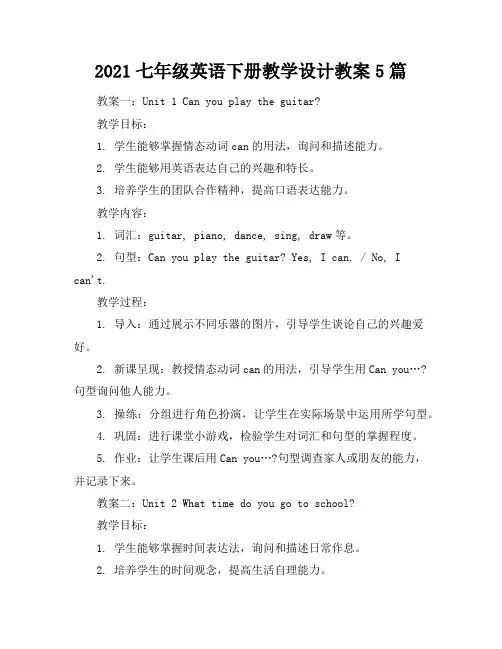
2021七年级英语下册教学设计教案5篇教案一:Unit 1 Can you play the guitar?教学目标:1. 学生能够掌握情态动词can的用法,询问和描述能力。
2. 学生能够用英语表达自己的兴趣和特长。
3. 培养学生的团队合作精神,提高口语表达能力。
教学内容:1. 词汇:guitar, piano, dance, sing, draw等。
2. 句型:Can you play the guitar? Yes, I can. / No, Ican't.教学过程:1. 导入:通过展示不同乐器的图片,引导学生谈论自己的兴趣爱好。
2. 新课呈现:教授情态动词can的用法,引导学生用Can you…?句型询问他人能力。
3. 操练:分组进行角色扮演,让学生在实际场景中运用所学句型。
4. 巩固:进行课堂小游戏,检验学生对词汇和句型的掌握程度。
5. 作业:让学生课后用Can you…?句型调查家人或朋友的能力,并记录下来。
教案二:Unit 2 What time do you go to school?教学目标:1. 学生能够掌握时间表达法,询问和描述日常作息。
2. 培养学生的时间观念,提高生活自理能力。
教学内容:1. 词汇:o'clock, usually, often, always等。
2. 句型:What time do you go to school? I usually go to school at 7 o'clock.教学过程:1. 导入:通过谈论学生的日常作息,引导学生关注时间表达。
2. 新课呈现:教授时间表达法,引导学生用What time do you…?句型询问他人作息。
3. 操练:分组进行对话练习,让学生在实际场景中运用所学句型。
4. 巩固:进行课堂小游戏,检验学生对词汇和句型的掌握程度。
5. 作业:让学生课后记录自己一周的作息时间,并用所学句型进行描述。
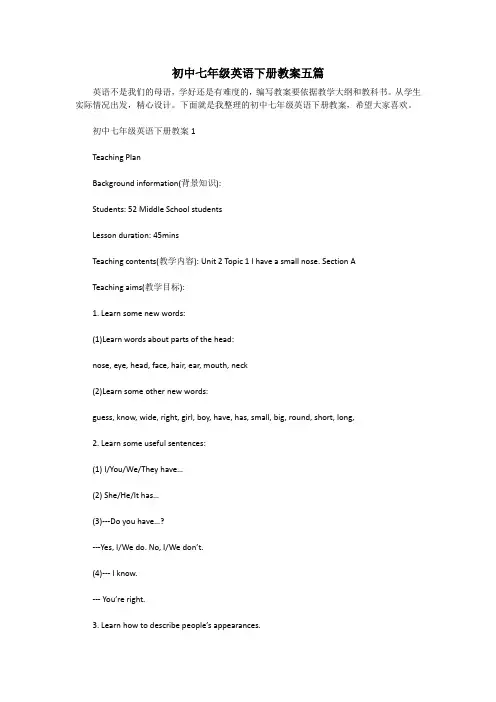
初中七年级英语下册教案五篇英语不是我们的母语,学好还是有难度的,编写教案要依据教学大纲和教科书。
从学生实际情况出发,精心设计。
下面就是我整理的初中七年级英语下册教案,希望大家喜欢。
初中七年级英语下册教案1Teaching PlanBackground information(背景知识):Students: 52 Middle School studentsLesson duration: 45minsTeaching contents(教学内容): Unit 2 Topic 1 I have a small nose. Section ATeaching aims(教学目标):1. Learn some new words:(1)Learn words about parts of the head:nose, eye, head, face, hair, ear, mouth, neck(2)Learn some other new words:guess, know, wide, right, girl, boy, have, has, small, big, round, short, long,2. Learn some useful sentences:(1) I/You/We/They have…(2) She/He/It has…(3)---Do you have…?---Yes, I/We do. No, I/We don’t.(4)--- I know.--- You’re right.3. Learn how to describe people’s appearances.Teaching focus(重点):words about parts of the head and adjectives of description Teaching difficulties(难点):The usages of have and hasTeaching procedures:(教学步骤)Step1 Warm-up 第一步热身greetingsing a song : Head and shoulders.Step2 Review 第二步复习(1) 通过复习,培养学生根据卡片信息进行简单交流的能力。
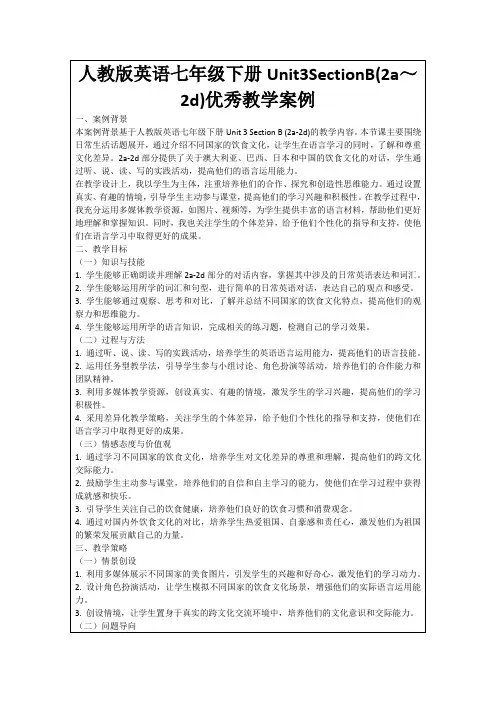
英语初一下册教学设计五篇教学过程,实际上是学生在教师指导下的认识过程。
学生是认识的主体,知识的掌握和潜力的培养只能在主体自己相应的用心自觉活动中才能构成。
下面是小编整理的英语初一下册教学设计5篇,欢迎大家阅读分享借鉴,希望大家喜欢,也希望对大家有所帮助。
英语初一下册教学设计1Unit 8 I’d like some noodles.I. Analysis of the T eaching Material1. Status and functionThe topic of this unit is about food. The students will learn how to order food ortake-away. In this unit, the students will be able to use “would like” to express their needfor food and learn how to ask others‟information and provide their personal informationduring the process.2. Teaching aims and demands1). Knowledge objectsa. To master how to order food or take-away;b. To master the modal verb “would” and “what” questions.c. To master the usage of countable nouns and uncountable nouns.2). Ability objectsd. To use “would like” to talk about the need for food.e. To improve students‟ ability of communication and social practice.3). Sensibility objects:Let the students experience the happiness of learning English,cultivate their abilityto do things and foster the spirit of cooperation in group activities.3. Teaching difficult points and focus:1)To learn the names of food and the countable and uncountable nouns.2)To learn how to order food.3)To use “would like” to express their need for food and learn how to order food.II. Target Language1) what would you/he/they like to eat?I‟d /He‟d /They‟d like some...2) What kind of noodles would you/he/they like?I‟d/He‟d /They‟d like beef and tomato noodlesIV. Vocabularynoodles, beef, chicken, mutton, potatoes, tomato, cabbage,carrot, dumplings, porridge, soup, green tea, orange juice, would like…V. Teaching Time45 minutesVI. Teaching ProceduresStep 1. Warm up.1) Show some pictures about sports and let the students answer the questions below:After doing these sports, what‟s your feeling?Are you tired ?Are you hungry?2) Let the students thinking the question: If you are hungry, what would you like to eat?3) Show some pictures of food that they have learned.Step 2. Lead into.1)T: “No food left! But don‟t worry, let‟s go to the restaurant to have a big meal.Look! What can you see in the restaurant?Yes, There are many kinds of food there. You can choose whatever you like”.2)Show the new words.3)Questions:A: What kind of vegetables/meat/food/drink would you like?B: I‟d like some…Let the students to learn the names of food and the countable and uncountable nouns. Let the students make some dialogue.Step 3. Let’s chant.Step 4. Noodle House.1) Show some pictures about noodle specials.meat+vegetables → special1/special2….(let the students to guess the meaning of the word …special ‟)2) Make dialogueA: What kind of noodles would you like?B: I‟d like…and…noodles.Step 5. Pairwork and guessing game1) Pairwork . (Make dialogues.)2) Game: Who is the winner?Ask a boy and a girl come before the blackboard, and then ask two students to make adialogues. The boy or the girl who find the right special will win one score….aftersome pairwork, see who is the winner? The boy or the girl.3) Guessing game.Step 6. Role Play (In the Nodle House)A customer and a waiter. (Make a dialogue)Let the students express their need for food and learn how to order food.Step 7. SummaryStep 8. ApothegmStep 9 A Flash → “I’m hungry”英语初一下册教学设计2课前准备教师:准备游戏时所用的图片(食物、蔬菜、动物)。
七年级英语教学设计详细教案(精选7篇)初一英语教案篇一【课题】Unit1 My name’s Gina.【学习目标】知识与能力:1、掌握并规范字母Ii-Rr.2、识记本单元词汇:what, this, in, English, a, an, map, orange, jacket, key, quilt, pen, ruler, spell, please, etc.过程与方法:学会从对话中获取对方的相关信息。
情感态度与价值观:使学生学会如何礼貌的与他人交往。
【学习重难点】:熟练掌握本单元词汇及语言结构。
一、自主预习【预习任务】:任务一:写出下列汉语的英语形式。
名字xx遇见xx问题,难题xx 回答,答案xx第一的x 最后的xx任务二:写出下列单词的汉语意思。
1、my2、clock3、nice4、what5、your6、hello7、I8、you9、his10、her11、name12、are一三、is【预习诊断】:1、选择题:(1)Kate has lost(丢失) _________key、_________asked _________for help、A、her ,he, IB、his, he ,meC、his, she, ID、her, she, me(2)_________plus(加) seven is thirteen?A、FiveB、SixC、EightD、Nine(3)_________is her name?A、whoB、what C where D、How2、写出下列英语形式。
(1):电话号码?_________(2):早晨好_________(3):下午好_________3、写出下列词的英语意思:1)、早晨_________2)、下午_________3)、晚上_________4)、谢谢_________5)、名字_________6)、好的_________or_________【预习反思】:你还有什么问题吗?(Do you have any problems?)二、课中实施Step1 交流展示Step2 精讲点拨:What’s your name?你叫什么名字?句中的your可根据问对象换成his、her等物主代词。
新版PEP小学英语七年级下册全册教案教学目标本教案旨在帮助七年级学生掌握下册英语书中的全部知识点和技能。
具体教学目标如下:- 听力:能够听懂简单的日常用语和指令- 口语:能够用英语进行简单的日常交流- 阅读:能够阅读简单的英语短文,并理解其基本内容- 写作:能够写出简单的英语句子和短文教学内容本教案包含全册的全部教学内容,包括各单元的词汇、语法和对话练等。
具体内容如下:Unit 1 - Greetings- 词汇:hello, hi, good morning, good afternoon, good evening- 语法:句子结构和基本问候用语Unit 2 - Family- 词汇:family members (father, mother, brother, sister, etc.), grandparents- 语法:形容词的比较级和最高级Unit 3 - School- 词汇:classroom, teacher, student, desk, chair, etc.- 语法:可数和不可数名词,数量词...(继续列举后续各单元的内容)教学方法本教案采用多元化的教学方法,包括教师讲解、学生互动、多媒体辅助等。
教师可以根据学生的实际情况和教学需要,灵活使用以下方法:- 听力训练:播放录音,让学生跟读或回答问题- 口语练:参与对话,进行角色扮演- 阅读理解:根据短文内容回答问题,进行课堂讨论- 写作练:写出简单的英语句子和短文,进行作业批改教学评估为了评估学生对教学内容的掌握程度,可以采用以下评估方法:- 听力测试:播放录音,要求学生根据听到的内容选择正确答案- 口语表达:进行对话练,评估学生的口语交流能力- 阅读理解:提供一篇简短的英语短文,要求学生回答相关问题- 写作任务:布置相关的写作任务,评估学生的写作水平教学资源本教案需要使用以下教学资源:- 新版PEP小学英语七年级下册教材- 听力录音文件- 多媒体设备(投影仪、电脑等)以上是新版PEP小学英语七年级下册全册教案的概要。
七年级英语下册教案及教学反思教案是七年级英语教师日常备课的产物,其代表着教师对课堂的假设与预想。
为大家整理了七年级英语下册教案,欢迎大家阅读!七年级英语下册教案Unit 2 Why do you like koala bears?一.教学目标:谈论自己的喜好;询问他人的喜好;能够谈论喜爱某种动物的理由;做出自己的行动计划。
二.教学向导三.重点句型Why do you want to see the pandas?Because theyre cute.Why does he like the koala bears?Because they are kind of interesting.What animals do you like?I like penguins. They are cute.What other animals do you like?I like dogs, too.Where are lions from?They are from Africa.四.教学步骤:Step 1: Lead-in Show parts of animals bodies by slide show, let students guess what animals they are.Then students show the pictures of all kinds of animals they found before class, and do a brief introduction of the pictures.Step 2: Task one: make a survey: what animals do your group mates want to see?Listen to the tape and finish Section A, 2a and 2b;Ask group mates what animals they want to see in a zoo, fill in the chart as below:Presentation: show their pair workreport: Lucy wants to see pandas. She thinks pandas are very cute and friendlyStep 3: Task two: make decision what animals your group wants to see in a zoo.1. choose the most popular three animals in ones group;2. listen to the tape, finish Section B, 2a and 2b;3. make a plan when you go to a zoo with your group mates. Givea dialogue sample:Boy: Where do you want to go now?Girl: Lets see the elephants.B: The elephants? Why do you like elephants?G: Oh, theyre interesting. And they are really intelligent. B: Yes, but they are ugly, too.G: Oh, Tony! So, where do you want to go?B: Lets see the pandas. They are kind of cute.G: Oh, yeah. I love pandas. Theyre beautiful. But they are also kind of shy. Where are they?B: Theyre over there on the left, just across from the koala bears. Step 4: Task three: We are going to the Beijing zoo for Autumn Outing, draw the order your group see animals at the zoo and state your reasons. Group work:1. draw a map of the zoo like the picture on P7; (according to the map of Beijing zoo)2. mark the order your group see animals;3. state the reasons like: Lucy, Mary and I like pandas best because they are lovely and beautiful, so we go to see pandas first. Then Step 5: Homework: Task:If you have a wild animal zoo, what animals do you want to put in your zoo?Draw a map of your zoo and state why you have these wild animals.教学点评及反思:一.环节设计思路:本课以游戏形式的猜动物名称引入,首先让学生通过游戏中的练习,尽快熟悉各种动物的英文名称。
新人教版七年级英语下册教案课堂能否进行高效率授课,学生与老师之间能否做到默契配合,教师能否让一节课的内容合理分布在课堂的每一个细节,这些都有赖于教师的教案设计是否符合学生的整体情况。
下面是小编为大家精心整理的新人教版七年级英语下册教案,仅供参考。
新人教版七年级英语下册教案(一)Unit 1 Section B (3a-Self Check)教学目标:1. 语言知识目标:1) 复习询问或谈论自己或对方在某一方面的能力和特长,讨论参加某一个俱乐部。
2) 能够综合运用所学的知识,就自己的熟悉的内容来介绍自己或他人所俱有的能力及特长;3) 总结回顾一些常见的一些表达人们能力的词汇,并能进行分类记忆。
2. 情感态度价值观目标:1) 能了解自己的一些特长,并运用自己的一技之长为他人或社会做一些有益的事情。
2)新人教版七年级英语下册教案(二)教学重难点1. 教学重点:1)2)能运用自己所学的相关英语语言知识,模仿所学过的相关材料来制作简单的广告。
2. 教学难点:的广告。
新人教版七年级英语下册教案(三)教学过程Ⅰ. Warming- up and revision1. Have a dictation of the new words and expressions.2. Let some Ss retell what Peter, Alan and Ma Huan can do.3. Let some Ss to read the three ads again.Ⅱ. Presentation1. T: Who's he?Ss: He's Liu Huan.T: What does he do?Ss: (Help Ss to answer) He's a famous musician.Write the words musician on the Bb.music 音乐→ musician音乐家拓展: teach教→teacher老师Ⅲ. Practice1. T: Next week we'll have a music festival. So we need some musicians to help with the music festival. I wrote an ad the box.2.Ⅳ. Writing3. 2b或3a中的广告的样子来写。
七年级下册英语课教案【篇一:人教版七年级英语下册unit 1教案】unit 1 can you play the guitar?section a (1a-2d)一、教学目标:1. 语言知识目标:1) 能掌握以下单词:guitar, sing, swim, dance, chess, play chess, draw, speak, speak english, join, club能掌握以下句型:①—can you play the guitar? —yes, i can./ no, i cant.②—what can you do? —i can dance.③—what club do you want to join? —i want to join the chess club.2) 能了解以下语法:情态动词can的用法want to do sth.的用法2. 情感态度价值观目标:该部分内容贴近学生的生活,谈论的话题是能力。
通过互相询问或谈论自己或对方在某一方面的能力,可以培养学生的一种群体意识。
二、教学重难点1. 教学重点:1) 学习询问和谈论彼此的能力和特长;2) 掌握一些弹奏乐器的表达方式。
2. 教学难点:情态动词can的构成和使用。
三、教学过程Ⅰ. lead in1. 教师可携带一些易于演奏的乐器,也可带一些演奏乐器的图片,一边演示乐器,一边说: i can play the guitar.…等;再指着图片说:he/shecan play the violin.but i can’t play it.等;然后询问学生:can you play the guitar?….并引导学生进行简单的回答。
2. ss look at the picture in 1a. then read the words and phrases. let ss match theactivities with the people.then check the answers with the class together.Ⅱ. presentationⅢ. game (what can i do?)t: tell your partners what you can do. for example:ss work in groups. the let some ss talk to their classmates in front of the class. Ⅳ. listening1. t: now let’s listen to the tape, find out the right conversation, and number them1-3.(播放lb部分的录音让学生听,引导学生根据所听到的内容,选出对话的顺序,完成1b部分的教学任务。
)2. check the answers:(3, 2, 1 )Ⅴ. pair work1. ask the ss to practice the conversations in 1b with a partner. then make their own conversations.(引导学生展开pairwork活动,完成lc部分口语交际的教学任务,学会运用can询问和表达能力。
)Ⅵ. listening1. work on 2a;t: now, look at the pictures on p2, listen to the four conversations. just listen.(play the recording for the first time, students only listen carefully.)then, listen to the recording again, and circle the clubs you hear.check the answers with the class.2. work on 2b;引导学生根据对话内容用正确的单词填空,补全对话,再播放听力材料一遍。
让学生进行校对,练习听力和写作能力,完成2b部分的教学任务。
check the answers with the ss.Ⅶ. pair work1. look at 2b and talk about what the people can do and the clubs they want to join.老师可以和一名优秀的学生做一个对话的例子,让学生们明白如何去问答,例如:t: what club does lisa want to join?s1: she wants to join the chess club.t: can she play chess?s1: no, she cant.2. ss work in pairs to practice asking and answer about lisa,bob and mary.3. ask some pairs to act out their conversations.Ⅷ. role-play1. ask ss to look at the picture in 2d. then ss read the dialogue by themselves and tryto find out the answers to these questions.① what club does bob join?② what club does jane join?ss read the conversation by themselves and find the answersto the questions. then check the answers:① bob joins the soccer club.② jane joins the english and art club.2. explain something that ss cant understand.3. let ss read after the teacher or play the recording and let ss read after therecording.4. ss work in pairs to act out the conversation.5. ask some pairs come to the front of the classroom. they tryto act out the conversation. see which group is the best.homework:1. remember the new words and expressions after class.2. recite the conversation after class.3. write english names as many as possible in the exercises book.板书设计:section a (grammar focus-3c)一、教学目标:1. 语言知识目标:1) 继续练习运用情态动词can。
学会询问和谈论彼此的能力和特长。
能掌握以下句型:①—can you play the guitar? —yes, i can./ no, i cant.②—what can you do?—i can dance.③—what club do you want to join? —i want to join the chess club.2. 情感态度价值观目标:该部分学习询问或谈论自己或对方在某一方面的能力和特长,可以培养学生的一种群体意识,促进同学们对自身的认识,为将来的自我发展奠定基础。
二、教学重难点1. 教学重点:1) 让学生重点总结、发现情态动词can的用法。
2) 通过一些与学生们实际生活相贴近的教学活动,来达到熟练运用的目的。
2. 教学难点:1) 情态动词can的用法;2) 在实际交际活动中运用can来询问与表达自己或他人的能力。
三、教学过程Ⅰ. warming- up and revision1. ask some ss about their abilities.t: hi, s1! what can you do?s1: i can sing and dance?t: can you play the guitar?s1: sorry, i cant. but i can play chess.t: what club do you want to join?s1: i want to join the chess club.2. role-play.let some pairs role play the conversation in 2c.Ⅱ. grammar focus.1. 阅读指导:2. 学生阅读grammar focus中的句子,然后做填空练习。
①你会游泳吗?______ you ______?②是的,我会。
/ 不,我不会。
yes, ____ _______. / no, i _______.… (其余试题见课件部分)3. 学生们完成填空试题后,可以打开课本检查答案,对错误的句子,单独进行强化记忆。
Ⅲ. try to find老师将情态动词的can的用法,以学案的方式呈现在大屏幕上,让学生自主学习,并发现其用法。
1. 可以看出,在can…?句型中,情态动词can没有________和_______ 的变化。
2. 用情态动词can来询问他人的能力可以归纳为以下句型:can + _______+ _________ + 其他?肯定回答:_________________否定回答: _________________what + can + _______ + ________ ?学生们合作学习讨论上面学案的答案,总结情态动词can的用法。
老师找部分学生对上述问题作答,并一起讨论总结情态动词can的用法。
Ⅳ. practice1. look at 3a. 告诉学生们用所给的词汇来造句子。
首先,用情态动词can及所给的【篇二:人教版七年级英语下册unit 6教案】unit 6 i’m watching tv.section a 1 (1a-2d)一、教学目标:1. 语言知识目标:1) 能掌握以下单词: newspaper, use, soup, wash, movie, just 能掌握以下句型:①—what are you doing?—im watching tv.②—whats he doing?—hes using the computer.③—what are they doing? —theyre listening to a cd.④—this is jenny. —its laura here.2) 能掌握语法:现在进行时态的用法。